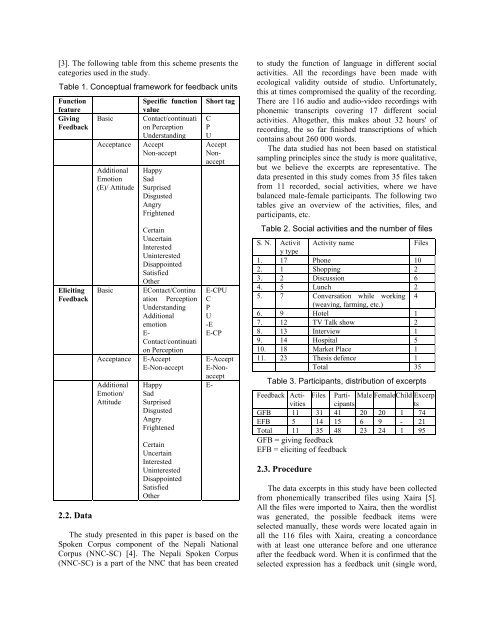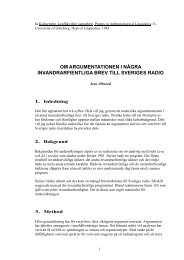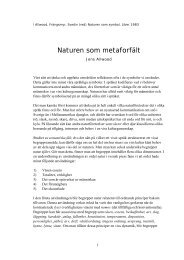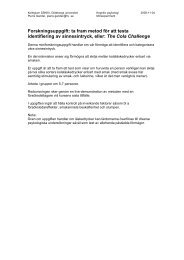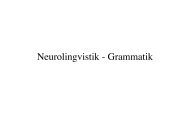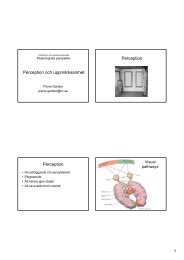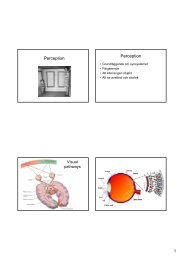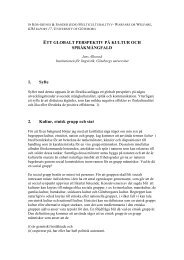Intonation Patterns in Nepali Feedback Units
Intonation Patterns in Nepali Feedback Units
Intonation Patterns in Nepali Feedback Units
Create successful ePaper yourself
Turn your PDF publications into a flip-book with our unique Google optimized e-Paper software.
[3]. The follow<strong>in</strong>g table from this scheme presents the<br />
categories used <strong>in</strong> the study.<br />
Table 1. Conceptual framework for feedback units<br />
Function<br />
feature<br />
Giv<strong>in</strong>g<br />
<strong>Feedback</strong><br />
Elicit<strong>in</strong>g<br />
<strong>Feedback</strong><br />
2.2. Data<br />
Specific function<br />
value<br />
Basic Contact/cont<strong>in</strong>uati<br />
on Perception<br />
Understand<strong>in</strong>g<br />
Acceptance Accept<br />
Non-accept<br />
Additional<br />
Emotion<br />
(E)/ Attitude<br />
Happy<br />
Sad<br />
Surprised<br />
Disgusted<br />
Angry<br />
Frightened<br />
Certa<strong>in</strong><br />
Uncerta<strong>in</strong><br />
Interested<br />
Un<strong>in</strong>terested<br />
Disappo<strong>in</strong>ted<br />
Satisfied<br />
Other<br />
Basic EContact/Cont<strong>in</strong>u<br />
ation Perception<br />
Understand<strong>in</strong>g<br />
Additional<br />
emotion<br />
E-<br />
Contact/cont<strong>in</strong>uati<br />
on Perception<br />
Acceptance E-Accept<br />
E-Non-accept<br />
Additional<br />
Emotion/<br />
Attitude<br />
Happy<br />
Sad<br />
Surprised<br />
Disgusted<br />
Angry<br />
Frightened<br />
Certa<strong>in</strong><br />
Uncerta<strong>in</strong><br />
Interested<br />
Un<strong>in</strong>terested<br />
Disappo<strong>in</strong>ted<br />
Satisfied<br />
Other<br />
Short tag<br />
C<br />
P<br />
U<br />
Accept<br />
Nonaccept<br />
E-CPU<br />
C<br />
P<br />
U<br />
-E<br />
E-CP<br />
E-Accept<br />
E-Nonaccept<br />
E-<br />
The study presented <strong>in</strong> this paper is based on the<br />
Spoken Corpus component of the <strong>Nepali</strong> National<br />
Corpus (NNC-SC) [4]. The <strong>Nepali</strong> Spoken Corpus<br />
(NNC-SC) is a part of the NNC that has been created<br />
to study the function of language <strong>in</strong> different social<br />
activities. All the record<strong>in</strong>gs have been made with<br />
ecological validity outside of studio. Unfortunately,<br />
this at times compromised the quality of the record<strong>in</strong>g.<br />
There are 116 audio and audio-video record<strong>in</strong>gs with<br />
phonemic transcripts cover<strong>in</strong>g 17 different social<br />
activities. Altogether, this makes about 32 hours' of<br />
record<strong>in</strong>g, the so far f<strong>in</strong>ished transcriptions of which<br />
conta<strong>in</strong>s about 260 000 words.<br />
The data studied has not been based on statistical<br />
sampl<strong>in</strong>g pr<strong>in</strong>ciples s<strong>in</strong>ce the study is more qualitative,<br />
but we believe the excerpts are representative. The<br />
data presented <strong>in</strong> this study comes from 35 files taken<br />
from 11 recorded, social activities, where we have<br />
balanced male-female participants. The follow<strong>in</strong>g two<br />
tables give an overview of the activities, files, and<br />
participants, etc.<br />
Table 2. Social activities and the number of files<br />
S. N. Activit<br />
y type<br />
Activity name Files<br />
1. 17 Phone 10<br />
2. 1 Shopp<strong>in</strong>g 2<br />
3. 2 Discussion 6<br />
4. 5 Lunch 2<br />
5. 7 Conversation while work<strong>in</strong>g<br />
(weav<strong>in</strong>g, farm<strong>in</strong>g, etc.)<br />
4<br />
6. 9 Hotel 1<br />
7. 12 TV Talk show 2<br />
8. 13 Interview 1<br />
9. 14 Hospital 5<br />
10. 18 Market Place 1<br />
11. 23 Thesis defence 1<br />
Total 35<br />
Table 3. Participants, distribution of excerpts<br />
<strong>Feedback</strong> Acti- Files Parti- Male Female Child Excerp<br />
vitiescipants ts<br />
GFB 11 31 41 20 20 1 74<br />
EFB 5 14 15 6 9 - 21<br />
Total 11 35 48 23 24 1 95<br />
GFB = giv<strong>in</strong>g feedback<br />
EFB = elicit<strong>in</strong>g of feedback<br />
2.3. Procedure<br />
The data excerpts <strong>in</strong> this study have been collected<br />
from phonemically transcribed files us<strong>in</strong>g Xaira [5].<br />
All the files were imported to Xaira, then the wordlist<br />
was generated, the possible feedback items were<br />
selected manually, these words were located aga<strong>in</strong> <strong>in</strong><br />
all the 116 files with Xaira, creat<strong>in</strong>g a concordance<br />
with at least one utterance before and one utterance<br />
after the feedback word. When it is confirmed that the<br />
selected expression has a feedback unit (s<strong>in</strong>gle word,


